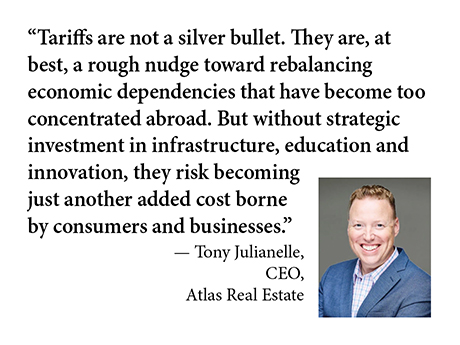By Tony Julianelle, CEO, Atlas Real Estate
The recent surge of tariffs on imports of goods from a bevy of countries has triggered a new round of economic debates — and for good reason. As the situation unfolds and develops, three questions keep coming up that are especially important for real estate investors, business leaders and homeowners alike:
• Will tariffs significantly raise building costs and home prices, or are these fears overstated?
• Could tariffs genuinely foster economic stability and stimulate American manufacturing and jobs?
• How can the real estate community strategically navigate or even capitalize on these changes?
Let’s break it down.

Are Higher Building Costs, Home Prices Inevitable?
In the short term, it’s hard to ignore the facts: tariffs are taxes, and when imported building materials are taxed, construction costs go up. The National Association of Home Builders estimates that recent tariffs could raise the cost of building a new home by about $9,200 on average. For anyone already feeling the squeeze of high mortgage rates and limited inventory, this is unwelcome news.
But it’s important to separate short-term reaction from long-term reality. Tariffs will create localized inflationary pressures, but their magnitude compared to other market forces — land availability, labor costs, zoning regulations, energy prices — is relatively small. Housing affordability remains a multi-factor problem, and while tariffs exacerbate it, they aren’t the root cause.
Market adaptation is key over the long term. Builders will look to domestic alternatives, explore different material mixes and refine construction techniques to minimize costs. Necessity often breeds innovation, and the industry could see accelerated adoption of practices such as modular housing, 3D-printed construction or domestic material manufacturing as a direct response to tariff pressures.
Can Tariffs Truly Boost Manufacturing?
Proponents argue that tariffs are a necessary disruption, a catalyst to rebuild the U.S. industrial capacity that has been hollowed out by decades of globalization. There’s a compelling logic here: strategic sectors like semiconductors, steel, pharmaceuticals and clean energy should have domestic resiliency.
But context matters. Historically, tariffs alone haven’t driven sustainable industrial revivals. Without coordinated investment in infrastructure, education, research and development and incentives for private-sector innovation, tariffs can end up as a blunt instrument that raises costs without achieving the broader goals.
In the short term, companies are likely to sit tight. Major capital allocation decisions, like opening new factories, hinge on political stability and predictability, not just one election cycle. The uncertainty around future policy reversals will likely freeze large-scale reshoring until after the 2028 election.
If, however, a durable, bipartisan consensus emerges that “Made in America” is a long-term national priority — supported by workforce training, favorable tax treatment and streamlined permitting — then tariffs could be the first awkward step toward genuine economic rebalancing. But that’s a big “if.”
How Should Investors Respond?
For commercial real estate investors and single-family homeowners, navigating this environment requires clarity and discipline, as evidenced by the following practices:
• Monitoring Industrial Real Estate Trends: If even a fraction of global supply chains reshore, demand for logistics hubs, light manufacturing space and secondary port markets will rise. Early movers who position assets in these corridors could see significant upside.
• Hedging Against Inflation: Tariff-driven cost increases could reinforce structural inflation. Real estate remains a favored asset class in inflationary times, as property values and rents often adjust upward. Investors should prioritize assets with strong cash flows and the ability to reprice rents.
• Optimizing Capital Structures: With interest rates now potentially facing volatility, locking in fixed-rate debt where possible could be a powerful defensive move. Those with flexible capital and liquidity will be positioned to take advantage of distressed opportunities if volatility spikes.
• Diversifying Geographic Exposure: Some regions could be hit harder than others. Areas heavily reliant on imports or export-driven economies may experience more acute pain. Balancing portfolios across diverse economic bases is a prudent strategy.
• Exploring Alternative Construction Methods: Builders should investigate modular, prefabricated or hybrid construction models that reduce reliance on heavily tariffed materials. Forward-thinking adaptation could create cost advantages in a constrained environment.
The Bigger Picture
Tariffs are not a silver bullet. They are, at best, a rough nudge toward rebalancing economic dependencies that have become too concentrated abroad. But without strategic follow-through — investment in infrastructure, education and innovation —they risk becoming just another added cost borne by consumers and businesses alike.
As investors, builders and citizens, our job is to look past the noise. Stay informed. Stay flexible. And remember: real opportunities often emerge in periods of disruption.
Tony Julianelle, CEO of Atlas Real Estate, has over 25 years of executive leadership experience in the finance and real estate industries. Before joining Atlas Real Estate, he was a senior leader at a major bank, overseeing cross-functional teams in the United States and overseas. He leads the overall strategy and direction of Atlas Real Estate while maintaining a relentless commitment to the firm’s values and culture.


